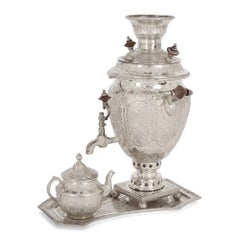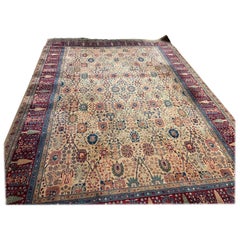Persian Samovar
Small Engraved Silver Part-Tea Service of Persian Design
Located in London, GB
Small engraved silver part-tea service of Persian design
Persian, 20th Century
Samovar: Height 23cm
Category
20th Century Persian Tea Sets
Materials
Silver
Recent Sales
Karastan Samovar Teawash Persian Vase Wool Area Rug 10' by 14'
By Karastan
Located in West Hartford, CT
Elegant, large Karastan Samovar Teawash wool rug. What makes this piece so magnificent is the
Category
Late 20th Century Persian Rugs
Materials
Wool
Karastan 900-906 Samovar Teawash Wool Carpet Area Rug Feraghan Saruk
By Karastan
Located in Dayton, OH
Karastan 900-906 Samovar Teawash wool carpet area rug Feraghan Saruk 8'8 x 10'.
Category
20th Century Persian Rugs
Materials
Wool
Silver Persian Samovar Set
Located in Salt Lake City, UT
Persian Silver Samovar set with carved wood handles and knobs, a teapot with carved handle, a
Category
Early 20th Century Persian Serving Pieces
Materials
Silver
People Also Browsed
Striking Art Nouveau Ceramic and Bronze-Mounted Vase in Victor Horta Style
By Victor Horta
Located in Lisse, NL
Top condition and pure elegance Art Nouveau vase.
For the collectors of museum quality and condition Art Nouveau ceramics. This stunning Art Nouveau vase is decorated with the mos...
Category
Early 20th Century European Art Nouveau Vases
Materials
Bronze
$2,882
H 10.75 in W 5.25 in D 4.4 in
Una 'Articolo Indeterminativo' Wood Chaise Longue
By Stefano Marolla
Located in Roma, IT
The chaise longue is the third piece of the collection Una (Articolo Indeterminativo) by Stefano Marolla. The name of the collection comes from the Italian grammar where the indeterm...
Category
2010s Italian Modern Chaise Longues
Materials
Wood
French Louis XVI Barometer
Located in Queens, NY
French Louis XVI (18th Century) barometer with original scientific illustrations and mercury vial framed with gilt foliate carvings & ebonized trim and a perched eagle pediment.
Category
Antique 18th Century French Louis XVI Scientific Instruments
Materials
Giltwood, Glass
19th Century Antique Italian Carved Walnut Bench by Valentino Besarel Ca 1870
By Valentino Besarel
Located in Encinitas, CA
Magnificent walnut hand-carved bench attributed to master artist Valentino Besarel (b. July 29 1829, d. Dec 11 1902) of Venice, Italy.
Renaissance Revival.
High quality; soft, fi...
Category
Antique Late 19th Century Italian Baroque Benches
Materials
Walnut
$6,000 Sale Price
20% Off
H 44 in W 42 in D 22 in
Italian Venetian Grotto Carved Seashell Rocker
By Pauly & Co.
Located in Queens, NY
Italian Venetian Grotto (19th cent.) silver gilt rocker with carved seashell seat & back and seahorse sides (att: Pauly et Cie, Venice)
Category
Antique 19th Century Italian Baroque Rocking Chairs
Materials
Silver Leaf
Fine Pair of Cut Rock Crystal Obelisks
Located in New York, NY
A fine and unusual pair of Art Deco hexagon form cut rock crystal obelisks, beautifully hand-cut and hand-polished, Paris.
Category
20th Century French Neoclassical Obelisks
Materials
Rock Crystal
Venetian Rococo Armchairs Sofa set hand-carved walnut , leather upholstered
Located in Vigonza, Padua
Early 20th Century Venetian Rococò armchairs and sofa by Atelier Cadorin Venice in hand-carved walnut and leather upholstered, wax polished
All the padding has been replaced with hig...
Category
Early 20th Century Italian Rococo Living Room Sets
Materials
Leather, Walnut
$42,031
H 39.38 in W 81.89 in D 41.34 in
1800s Venetian Sofa Valentino Besarel Attributet, Hand-Carved Walnut
By Valentino Besarel
Located in Vigonza, Padua
Elegant 19th century Venetian sofa, Valentino Besarel attributed, restored, wax-polished, in hand-carved walnut restored with light green temporary upholstery.
We can customized the ...
Category
Antique Mid-19th Century Italian Louis XV Sofas
Materials
Fabric, Walnut
$10,687
H 48.43 in W 70.87 in D 27.56 in
Late 19th Century Italian Baroque Revival Gilt and Polychrome Table Top Vitrine
Located in Austin, TX
An elegant late 19th century Baroque style tabletop vitrine. The vitrine marvelously carved and richly gilt in the Baroque manner, with beautiful foliate scrollwork and polychrome de...
Category
Antique Late 19th Century Italian Baroque Revival Vitrines
Materials
Velvet, Glass, Giltwood
$10,500
H 47 in W 29 in D 12 in
Rare and Unusual 19th Century Louis XVI Style Dog/ Doll Bed or Baby Crib
Located in Buchanan, MI
Rare and unusual 19th century Louis XVI style dog/ doll bed or baby crib. The ultimate in luxury for your little furry friend.
Category
Antique 19th Century French Louis XVI Children's Furniture
Materials
Walnut
$4,500
H 38 in W 60 in D 31 in
Italian Rococo Style Carved Giltwood Filigree Wall Mirror
Located in Queens, NY
Italian Rococo (Florentine, 19th Century) giltwood wall mirror with extensive foliate carved filigree frame with a shell form pediment top.
Category
Antique 19th Century Italian Rococo Wall Mirrors
Materials
Gold Leaf
Original 1948 Baccarat Crystal Sun Clock
By Baccarat
Located in Los Angeles, CA
The designs of Georges Chevalier (1894-1987), who was artistic director of Baccarat from the 1920s to the 1970s, were largely responsible for propelling Baccarat into the modern era....
Category
Vintage 1940s French Art Deco Wall Clocks
Materials
Crystal, Metal, Brass, Iron
Cutler & Girard, Sailing Ships, Inlaid Three-panel screen, Italy, 1902
By Cutler & Girard
Located in New York, NY
An Italian folding screen in the Liberty Style (the Italian equivalent of Art Nouveau) by the Florentine furniture makers Girard & Cutler who earned the Gold Medal during the Turin E...
Category
Early 20th Century Italian Art Nouveau Screens and Room Dividers
Materials
Mahogany, Maple, Walnut
$120,000
H 1.5 in W 64 in D 71.75 in
Hand Embroidered Mughal silk and metal threaded tapestry, India
By Rajhastani
Located in Moreno Valley, CA
Hand embroidered and quilted textile from North India.
Large Mughal silk and metal threaded tapestry
Fanciful Asian folk designs this distinctive quilt work is a true sense of artist...
Category
20th Century Indian Anglo Raj Textiles
Materials
Silk
Mughal Hand Embroidered Metal Threaded Tapestry from Rajasthan, India
By Rajhastani
Located in Moreno Valley, CA
Hand embroidered and quilted textile from North India.
Mughal silk and metal threaded tapestry.
Backed with black linen.
Fanciful Asian folk designs this distinctive quilt work is a ...
Category
20th Century Indian Anglo Raj Textiles
Materials
Cotton
$1,500
H 57.5 in W 38 in D 0.05 in
Pair of Neoclassical Rock Crystal Spheres on Bronze Bases
Located in Cypress, CA
Impressive pair of hand-carved and hand polished rock crystal spheres on bronze dolphin bases, second half of 20th century.
The diameter of the rock crystal sphere is 7.5 inches.
...
Category
Late 20th Century European Neoclassical Centerpieces
Materials
Rock Crystal, Bronze
Get Updated with New Arrivals
Save "Persian Samovar", and we’ll notify you when there are new listings in this category.
Persian Samovar For Sale on 1stDibs
At 1stDibs, there are many versions of the ideal Persian samovar for your home. Frequently made of fabric, wool and cotton, every Persian samovar was constructed with great care. There are 73 variations of the antique or vintage Persian samovar you’re looking for, while we also have 1 modern editions of this piece to choose from as well. There are many kinds of the Persian samovar you’re looking for, from those produced as long ago as the 19th Century to those made as recently as the 21st Century. When you’re browsing for the right Persian samovar, those designed in Arts and Crafts, industrial and mid-century modern styles are of considerable interest.
How Much is a Persian Samovar?
The average selling price for a Persian samovar at 1stDibs is $8,460, while they’re typically $1,705 on the low end and $250,000 for the highest priced.
More Ways To Browse
Antique Persian Samovar
Vintage Afghan Hound
Vintage American Logs
Vintage and Antique Storage Boxes
Vintage Bakery Cases
Vintage Ballerina Figurine
Vintage Blue Creamer
Vintage Blue Glass Head
Vintage Boat Seats
Vintage Bouncer Chairs
Vintage Boy And Girl Figurines
Vintage Brass Deer Figurines
Vintage Brass Elephant Figurine
Vintage Brass Whale
Vintage Card Filing Cabinet
Vintage Carlton Ware England
Vintage Ceramic Clowns
Vintage Ceramic Hippo


